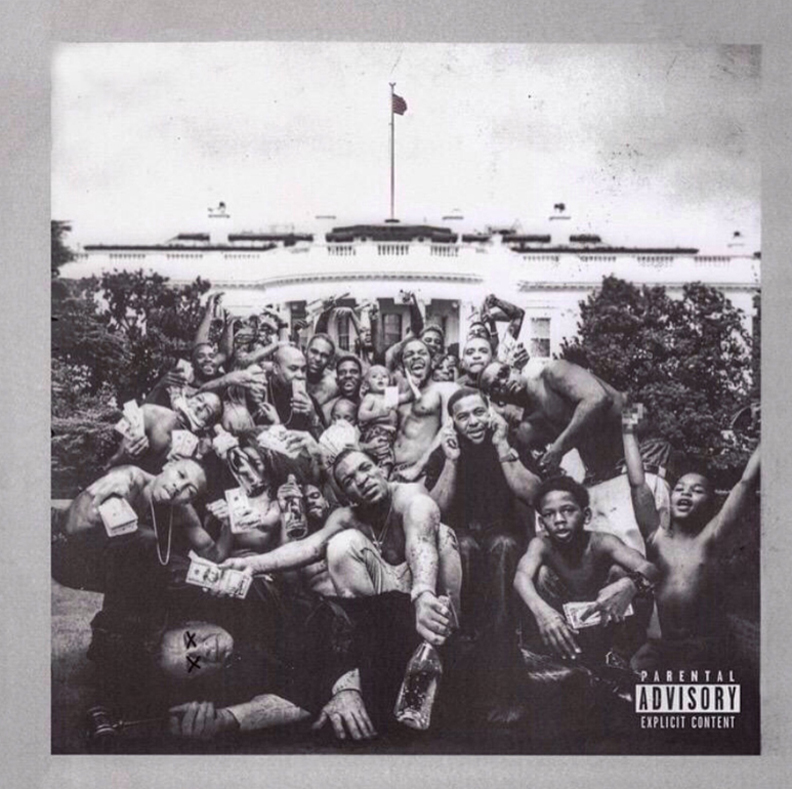Last week the wait for Kendrick Lamar‘s highly anticipated follow-up to good kid, m.A.A.d. city ended abruptly. The anticipation was quickly replaced with admiration and a splash of bewilderment. Whereas good kid, m.A.A.d. city was an autobiographical narrative punctuated with enough singles to keep fans satiated, To Pimp A Butterfly paints a massive and honest portrayal of American society with enough detail that would’ve made Basquiat grin.
Needless to say, To Pimp A Butterfly does not provide instant satisfaction. It’s an album that rewards multiple listens and deep analysis. At its core, To Pimp A Butterfly shares the same mission we first learned near the end of good kid, m.A.A.d. city when Kendrick’s mother tells him to give back to his city. The latter culminated in the Just Blaze produced “Compton” with its city specific hook and hometown hero Dr. Dre bragging about his headphones. To me, it was a weak ending to a fantastic movie. In my eyes, To Pimp A Butterfly rights that wrong by ending with a twelve minute song dripping with finality. “Mortal Man” contains the conclusion to Kendrick’s prose that is integrated line by line throughout the entire album. Upon finishing the album’s narrative, he turns to an archived interview with West Coast legend 2Pac for guidance. After soaking in 2Pac’s perspective on his rise to fame and the obstacles he faced, Kendrick hits back with his own philosophy, transcribed below:
“The caterpillar is a prisoner to the streets that conceived it.
Its only job is to eat or consume everything around it, in order to protect itself from this mad city.
By consuming its environment the caterpillar
begins to notice ways to survive.
One thing it notices is how much the world shuns him
but praises the butterfly.
The butterfly represents the talent, the thoughtfulness
and the beauty within the caterpillar.
But having a harsh outlook on life the caterpillar sees the butterfly as weak, and figures out a way to pimp it to his own benefits.
Already surrounded by this mad city the caterpillar goes to work on the cocoon, which institutionalizes him.
He can no longer see past his own thoughts, he’s trapped.
While trapped inside these walls certain ideas take root such as going home and bringing back new concepts to this mad city.
The result?
Wings begin to emerge, breaking the cycle of feeling stagnant.
Finally free, the butterfly sheds light on situations that the caterpillar never considered, ending the internal struggle.
Although the butterfly and caterpillar are completely different, they are one in the same.
What’s your perspective on that?”
The album ends on a question proposed to 2Pac, but Kendrick is really looking for an answer from the listener. Like Pink Floyd’s Animals before it, Kendrick has crafted an album that attempts to symbolize society with earthbound creatures. Roger Waters used sheep, dogs and pigs to represent the complacent, the cutthroat and the comfortable. Waters’ approach was bleak with seemingly no room for change. Dogs would fight each other while the pigs snorted and the sheep bleated. It was Waters’ way to spit on society like he did one of his fans.
Kendrick takes an entomological and more optimistic approach using caterpillars, cocoons and butterflies to describe not only his own metamorphosis, but the potential for change contained within everybody. Everyone starts out as a caterpillar and is faced with a choice: To become a butterfly or to pimp a butterfly.
To become a butterfly requires passing through the cocoon. Every caterpillar’s cocoon is different and dependent on its own surroundings. Kendrick’s cocoon was Compton. More specifically, identifying and overcoming the trappings of gang violence, racism, sex, alcohol, drugs and plenty of other details I’m sure I’ll discover with repeat listens in the coming months.
In the above butterfly philosophy, you may have noticed that the portion regarding cocoons contains the titles of two subsequent songs on the album. “Institutionalized” and “These Walls” detail the beginning stages of Kendrick’s cocoon. Before “Institutionalized” begins, the cocksure caterpillar’s theme “King Kunta” ends with the opening lines of the prose that Kendrick builds on throughout the entire album. After “These Walls” finishes, Kendrick has added lines to the prose to include him screaming in a hotel room (another symbol for his cocoon).
Everything between “u” and “i” on To Pimp A Butterfly details Kendrick’s metamorphosis using his faith, family and hometown to become a butterfly himself. His drunken struggle with his fame on “u” is eclipsed on “i” when he confidently reinforces his mission by quelling a disruptive crowd during his Grammy award winning single.
It’s a bittersweet ending knowing that there will be caterpillars cheering for Kendrick, but also those caterpillars that will dismiss his message while reinforcing their cocoon. Even if we can find it in ourselves to unlock our inner beauty and show others what they can become, we still live in a society where certain caterpillars pimp butterflies to justify their own cocoons. But to be a butterfly is to respect the caterpillar, as every butterfly has struggled with his own cocoon. It’s about empathy in the face of adversity.
But that’s just my perspective. What’s yours?






